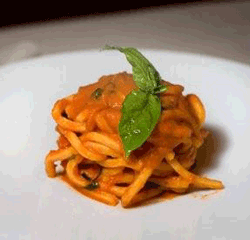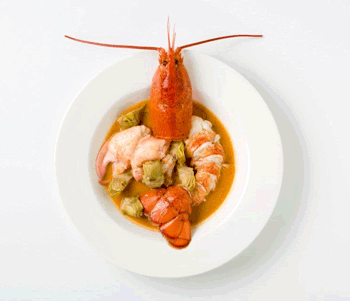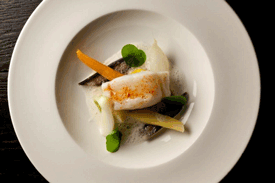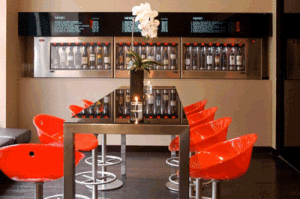THE PIONEER OF AUTHENTIC ITALIAN CUISINE IN USA
 |
|
Marisa and Tony May photo by Robert Caplin |
text ©2011 by Lucy Gordan
Tony May has been in the restaurant business in New York City for half a century. He is a “gastronomic ambassador and professor,” a living legend, who has done more than any other American restaurateur to expose chefs, restaurateurs, journalists and the dining public to genuine Italian cooking. Ever since graduating from university his only child, Marisa, has been his fulltime right-hand “man.” Lucy Gordan, Epicurean-Traveler.com’s Rome Bureau Chief, interviewed them both at SD26 (San Domenico at 26th Street) during her last visit to New York.
I always begin my interviews with “food” people with the same question: what are your earliest memories of food?
TM: Seafood, because my father was captain of a troop transport ship stationed in Taranto during World War II. When he came home, because during the war we lived in Taranto, he always brought seafood: mussels, clams and fish. I remember its preparation, more than its taste.
After the Armistice with Eisenhower in September 1943, we lived in the same building where the British army had its commissary. I would go downstairs and they would give me chocolate. I was about four or five when we moved to Taranto and about seven when we moved back to Naples, where both sides of my family were from.
My mother didn’t know how to cook; she didn’t even know how to boil water. She was too busy raising eight children. Her mother, my grandmother, or my aunt did the cooking in Taranto and in Naples.
If I have to tell you dishes that I particularly remember and liked, they would be steamed mussels and homemade bread with a very thick crust; it was incredible.
You were born in 1937 in Torre del Greco near Naples, the oldest of your parents’ eight children. At the end of the War you moved back to Naples so you must have vivid memories of Naples then; can you share some?
TM: I remember that we had lots more to eat than during the War in Taranto when we ate what we could scramble together. Of course, home again, my grandmother made Neapolitan dishes. Lots of soups, lots of pasta!
I remember first in Taranto and then in Naples running to bomb shelters. I remember that the building right next door to ours in Naples was bombed and razed to the ground. That was the closest we came to being hit. My grandfather, my father’s father, died during a bombing raid of Naples.

The bar at SD26 restaurant
You began your career in food service at age 17, as a commis on a cruise ship. The next year you went to London to study English for a few months, but then returned to the cruise ship, where by age 20, you were the maître d’. What was the name of the cruise ship?
TM: As a commis I worked in the dining room. I was never a cook. It wasn’t a cruise ship as we know them today. The ship took Italian immigrants to Argentina:from Naples to Buenos Aires. Its name was “Castel Bianco.”
Did you have a mentor on board?
TM: No. You know when you’re 17 years old, in post-War Italy and you need to work, you mature very quickly. I didn’t have a mentor, but as you work your way up, there’s always an older person that moves in as your counselor so to speak. I moved up the ranks very quickly. When I was 20 years old, as you said, I was already the maître.
During the 1950s Italy was impoverished, especially the south, so in 1963, at age 25, you moved to New York. What were your first impressions of New York?
TM: I worked on a number of so-called cruise ships from 1955 to 1963: ”Castel Bianco,” “Castel Felice,” for the Homeric and Italian Lines.
The first time I came to New York was in 1960 and then I came back on the “Italia” in 1963 on May 11th. In 1960 I immediately thought New York was an incredible city, a place I would like to work in. I wanted to move on. At that time Italy had nothing to offer to young people. I found New York very exciting, full of energy. It struck me that it would be an ideal place for me to come to work.
Your brother Mimmo, owner of “Buon Italia” at Chelsea Marketplace, also immigrated to the United States. What about your other brothers and sisters?
TM: Mimmo is no. 4. My brother Luciano, no. 5, also immigrated to the USA. He lives in Stamford, Connecticut. He owned a restaurant. We are five boys and three girls.
I’ve read that you were rightly appalled to discover how Italian-American food had evolved into something very differentfrom its roots; how did this happen? Was it a question of no olive oil? It can’t be only a question of ingredients because tomatoes, basil, flour, etc. were always present here; is it a question of quantity over quality because the first Italian-American immigrants were obviously hungry and poor? In short why do you think Italian-American cuisine was so awful?

Spaghetti at SD26
TM: It’s simple. You’re wrong; it was definitely a question of ingredients. No. 1, the American ingredients you’ve just mentioned were definitely totally different, not at all similar for the immigrants in taste and flavors to those we were accustomed to as we were growing up. No. 2, there was definitely a lack of understanding of Italian cuisine in New York. Very few professional “food people” or already professional chefs immigrated to America to open restaurants in the 1950s and 1960s, and to prepare the kind of food that we immigrants of that period were accustomed to back home. To make matters worse, most of the early Italian immigrants who’d come here at the turn of the century and had gone into the restaurant business were “invented,” improvisations; with very few exceptions they’d never been in the restaurant business before. No. 1, they would take their home cooking and transform it to a commercial level. No. 2, since they didn’t have the ingredients, they had to grow these ingredients which OK resembled the real ingredients in Italy, but they were not grown the way they had been in their hometown Italian villages when they first arrived. They bastardized Italian cuisine. The climate and soil were different after all. The unavailability of authentic Italian ingredients at first was the most important element.
The next generations of these early immigrants, who never went to Italy, continued to make their food like their immigrant ancestors thinking that it was authentic Italian cuisine. Therefore the foods and their tastes that the Italian-Americans were preparing when I arrived here in 1960s had nothing to do with the foods we were eating in Italy at that time. I’d never heard of or ever tasted most of their dishes that they were serving as Italian. Many also spoke a language I did not understand because it was a mixture of dialects, not Italian.
In the 1960s there were a few restaurants in New York that claimed to serve “northern Italian cuisine,” but they only called themselves “northern Italian” because they wanted to distinguish themselves from the southern Italian cuisine, which was being prepared by the descendents of the first Italian immigrants who’d gone into the restaurant business in the States and were southerners. The so-called “northerners” wanted to announce that Italian cuisine was not only red sauce and garlic. Basically their menus were like those in the large fancy hotels in Europe. Their dishes were more international. They invented “chicken tetrazzini” and “veal francese,” “fettuccine Alfredo,” all kinds of dishes full of butter, lard, and cream, something that, as you know, is foreign to Italian cuisine.
So they must not have had any olive oil, right?
TM: It was not a matter of not having it; they didn’t use it because it was not part of American culture. Olive trees grow only in California.
You were born Antonio Magliulo. Why did you change your name to Tony May?
TM: “Tony May” is my “stage name.” I invented it in 1968. It’s easier to remember and spell than Magliulo, and much easier to pronounce.
In 1971 you held your first “Italian Fortnight,” a two-week festival for which, perhaps for the first time, chefs were flown in from Italy to cook authentic Italian cuisine — a real revolution! Which chefs came?
TM: Yes, it was probably the first time that foreign chefs came to America to cook. I brought twelve chefs from the great Italian hotels of the CIGA chain, no longer in existence. Their director was the Executive Chef of the Excelsior in Venice.
Thinking about one of my favorite movies, The Big Night, was it more of a challenge to persuade Italian-Americans to eat genuine Italian food than other ethnic groups?
TM: As you said, our tastes in food are connected to our childhood memories and Italian-American cuisine never evolved. Italian-Americans were still cooking their ancestral dishes which were the early Italian immigrants’ adaptations of Italian cuisine, not real Italian cuisine. The change to appreciating real Italian cuisine did not start happening until the late 1970s when some restaurants started serving Italian cuisine as we know it today. This change was due to an influx of Italian food products to America like olive oil, pasta made in Italy, fresh cheeses, vegetables, so we could get closer to the way Italians were eating at the same time in Italy. We no longer had to eat repeat performances of bastardized Italian cuisine dating back to the 1890s. In short, if you come to my restaurant “SD26” now, you will eat the same way as you would in Italy. Say, my “spaghetti alla carbonara” will have the same ingredients and taste the same as in Rome.
Once in the United States, you quickly rose through the ranks and have for many years been considered the best Italian restaurateur in this country. What do you think is the reason for your enormous success?

Lobster at SD26
TM: W-O-R-K. Work. First of all, when I arrived in New York, I already had a basic knowledge of how to run a business. I spoke English perfectly. I was willing to work hard. I knew my profession. Therefore I moved along fairly quickly. Nonetheless, the first six months here in America, I almost went back to Italy because it was a little bit depressing here. Each time I changed to a better job, they would tell me that I was doing everything wrong, although I already had ten years experience in Italy and on boats. So I said to myself, “I think it’s these Americans who don’t know what they’re doing.” I had to make a quick decision. I had to decide to stay and follow the rules and adapt or leave. I decided to stay and wait until I had the chance to do things my way, when I was in a position to in fact do so. So that’s what I did. I started to work at “The Rainbow Room” in 1964. When I arrived in New York the year earlier, I’d set up a program for myself to work in many different restaurants, to understand the mentality, to understand the way Americans worked, to understand in which direction I should go. As I’ve told you, I’d already worked as a maître d’, as a hotel manager when I first arrived here, but to figure out my direction, I would go to a restaurant and apply for a job as a waiter. I would stay three or four weeks and then I’d leave and apply for a job as a waiter in another restaurant. I discovered that every place had a different system, which is totally contrary to what I’d been accustomed to. In Europe no matter where I worked, everyone worked the same way. In America everybody worked differently and everybody was right. God forbid, you would contradict your boss or the manager or the owner. You’d lose your job.
Can you tell me the names of some of these restaurants?
TM: Yes, my first job was at “The Colony.” My second job was at “The 21 Club.” My third job was at “Oscar Delmonico.” The fourth job was at “Orsini.” My fifth job was at “La Mediteranée” on Park Avenue and 63rd Street. Another job was at “Roma di Notte,” a night club. Then in March of 1964 I started working at “The Rainbow Room” as a captain.
So this was before you were married and before Marisa was born?
TM: No, I got married in the fall of 1963, six months after I came to America. Marisa wasn’t born until 1971.
Was your wife Italian or American?
TM: Italian-American. Her family was originally from Naples and Salerno.
After so many years of experience, what are your feelings about food critics and restaurant guides?
TM: Hey, wait a minute. You’re jumping over 40 years of my life. Let’s go back. I started working at “The Rainbow Room” in 1964 as a captain. I moved up very fast. By 1968 I was the General Manager. That’s when I changed my name to May. In 1973 I bought the lease. I couldn’t go any farther. I truly enjoyed my work. I still enjoy my work. To work is not a problem for me. Then in 1979 I instituted il gruppo ristoratori italiani, an association of restaurant owners whose objective was, and still is, to improve the image of Italian cuisine through education — at the restaurant level in our own restaurants — and at the institutional level in schools.At first we brought our members to Italy because we restaurant owners had to learn how the foods and culinary customs were evolving in each of Italy’s regions. Every year we also brought ten journalists to Italy with us in order for them to learn about the food of all the regions of Italy, so that they could experience the food and wine, as Italy was producing better foods and changing the way Italians ate. Food evolves; it’s not static. Traditions evolve.
Did you have a mentor in the USA or was it still your curiosity and your tenaciousness that made you such a success so fast?
 |
|
Poached Cod and heirloom carrots
|
TM: It’s difficult for me to choose one person who moved me up. I think what moved me up and made me a success was my hard work.
You have owned several of New York City’s famous restaurants:“The Rainbow Room,” “Palio,” “San Domenico,” “Pastabreak,” “Gemelli” and, since 2009 SD26. The first “Pastabreak” and “Gemelli” were in the World Trade Center. Where were you when you heard the news of the 9/11 attacks?
TM: At the World Trade Center I had “Gemelli” on the ground floor and “Pastabreak” on the Lower Level. The night before September 11 I had just returned from Italy and I had gotten up early because of jet lag. I was reading my mail and turned the television on and saw the two Twin Towers and that one of them was smoking. I thought to myself: “What on earth is going on?” So I immediately called the restaurant and the manager told me that they’d heard a loud blast, like an earthquake, and now there’s a fire and people jumping off the high floors. So I told him to lock everything up and get out. So that’s what they did and so we did not lose anybody.
I’ve read that, although none of your employees were killed that you worked tirelessly to help feed the rescue workers as well as to help your displaced employees. Can you go into a bit more detail?
TM: There wasn’t any point for me to go down because, once I got everybody out of there, before you knew it the second plane hit. The area was a disaster. Where was I supposed to go? What assistance could I have given? So I stayed home and watched this terrible drama on television. Later, I worked with other colleagues — Daniel Boulud, David Bouley, Drew Nieporent, Odette Fada and others — to provide the food for all the rescuers working there day and night to try to find survivors among the rubble. We cooked on temporary on-site kitchens.I tried to go down a few days later. I was about 200 feet away when I said to myself: “I’m not going any farther.” I couldn’t bring myself to go closer.
For around 20 years you’ve worked side-by-side with your daughter Marisa. Can you tell my readers a bit more about Marisa?
TM: When Marisa was born it was a great event in our life for me and my wife. She was a very rewarding child. She studied very hard. She went to public elementary school, then to Sacred Heart in Greenwich, and then to NYU. When she finished college, she simply came over to the restaurant (at that time “San Domenico”) and took over the desk. She’s a natural for this business. She likes people and works well with her team.
 |
|
photo by Robert Caplin
|
What zodiac signs are you?
TM: I’m a Sagittarius and Marisa is a Leo.
Often it’s difficult for a father and son or daughter to work together; how do you divide the responsibilities here at SD26?
TM: We find working together very easy. She is fairly independent. She always does what she thinks is best. I trust her and let her do whatever. We both follow the same guidelines and the guidelines are to make sure that the customer is happy whenever he or she comes to the restaurant.
What do you like the most about your work?
TM: My work is my hobby. I enjoy what I do. I enjoy food. I enjoy eating. I enjoy entertaining. I enjoy talking about food. I enjoy any research I do about food, and I enjoy the challenge that we have today in promoting Italian cuisine from its folkloristic image of regionalism — I think that regional cuisine is passé — to one national cuisine. I think that Italian cuisine is one national cuisine with regional products. The products are regional, but the cuisine is Italian. The folkloristic image of regionalism keeps Italian cuisine tied down to the trattoria level. We need to move up from the trattoria level to the high end like SD26, “Palio,” “Felidia,” “Del Posto.” They are no longer trattorie where we had the mamma and the papà in the kitchen; we are the top. People must understand that we Italians are like the French; they and we both have regional cuisine, family cuisine, and haute cuisine. In Italy we have always had it; it’s just that until recently we never brought it to America. The problem is that because for years our image was folkloristic and regional, it’s difficult to get the press to understand that Italian cuisine in America has evolved.
How often do you go to Italy?
TM: Four or five times a year. Sometimes I go to the north; sometimes I go to the south; sometimes I go to Rome. I go for different reasons. I still have my mother there. She’s 93; lives in Naples; and is in good health.
You wrote Italian Cuisine: Basic Cooking Techniques (2005), hailed as a title “destined to become a standard volume on the cookbook shelf.” Are you writing another cookbook?
TM: The first version of that book was done in 1991. We did it for schools. We distributed 60,000 free copies to all the cooking schools in the United States — the Culinary Institute of America, Johnson and Wells, you name it. We sent thousands of books to these schools. No, I’m not writing another cookbook yet.
You have had a full life, rising through the ranks, owning so many restaurants, teaching so many young chefs who are now famous, knowing so many VIPs, and receiving so many honors; have you ever considered writing your memoirs?

squab Casteluccio with Lentils
TM: No, I’ve never thought of writing my memoirs. I still have a long way to go.
Speaking of honors, which one or ones are you most proud of?
TM: Two. One was given to me at the Quirinal in Rome by the President of Italy, Luigi Scalfaro, in 1997 when “San Domenico” was selected one of the best 25 Italian restaurants in the world.The other one was a silver plate awarded to me in 1990 by the International Food Service Manufacturers Association (IFMA) at the annual Restaurant Show held every May in Chicago, as the Best Independent Restaurant Owner.
Up to now you’ve told me about Tony May the restaurateur. I’d like to know more about Tony May himself. For example, what are your favorite foods?
TM: I enjoy the simplicity and the fulfillment that Italian cuisine brings to the table and the pleasure of its authenticity in flavors and taste. There is nothing better than a simple tomato sauce with pasta cooked correctly. It sounds like an easy thing to prepare but it’s very difficult because the simpler the dish the more difficult it is to execute. It’s extremely important to start with the proper ingredients. The better your ingredients, the better is your Italian cuisine.I really think that today there is a huge misunderstanding, a misinterpretation of Italian cuisine and a tremendous number of people are taking tremendous liberties with Italian cuisine and they should not. Particularly the press, if you will, the American critical press sort of rejects the word authenticity because they say it’s not important. Of course it’s not important to them because they don’t understand it, so it’s a good copout. It’s a good way out. If you don’t understand something, you say it’s not important. It’s not important to you because you don’t understand it, but it’s important to me because I understand it. That’s a problem I’m having with the press at this moment. We’re experiencing right now a bit of a back lash where we find that the best-rated Italian restaurants in the country are all owned by native-born Americans, while native Italian chefs who are producing some excellent food are shunned aside. I resent this. I don’t think it’s fair. All of a sudden the American press is telling us that American chefs can cook better Italian cuisine than we can. That’s impossible. It doesn’t make sense.
Favorite wines?
TM: I enjoy wines period, and I like to have different wines with different foods. Barolo from Piemonte, Brunello from Tuscany, an Aglianico from Campania, Nero D’Avola from Sicily, a passito from Pantelleria. I enjoy good food and I like to match my good food with a good wine. I like a well-rounded, full-bodied wine with good flavor.

SD26 wine bar with nomadic wine-dispensing machine
A dish you don’t like?
TM: The only food I don’t eat is when I can’t recognize it on the plate.
“Food people” are known for having collections, often of fast cars, motorcycles, or watches, what about you?
TM: Of Neapolitan gouache, a type of watercolor. The artist would paint the background, a view – this was before the invention of photography – and then add in the tourist who bought the gouache. You find gouache of Naples mostly in England because of the Grand Tour. My hobby is golf.
Others restaurateurs you admire?
TM: I have a lot of respect for my peers: in Italy Gualtiero Marchesi, Angelo Paracucchi who unfortunately has passed away, and Pierangelo Cornaro in Bergamo; in America Daniel Boulud and Wolfgang Puck. They are all exceptional individuals who have done exceptional things in their careers as chefs. I admire the passion and the drive that they have all put into their work.
Other restaurants besides your own that you like to go to?
TM: I eat better in my restaurant than anywhere else. It’s not because I’m better than everybody else, but because I’m more accustomed to my cooks and their flavors. They know what I like and what I don’t like.
When I go out, it’s either to visit a colleague or to eat a dish that I cannot make in my restaurant. Or I go when I’m asked to visit a new restaurant. If there is one restaurant that I like because it’s a classic in its time, I would have to say “The Four Seasons Restaurant” here in New York.
Your favorite restaurants in Naples and Capri?
TM: “Ciro” in Naples and “Aurora” and “Fontelina” on Capri. Also my sisters Marisa and Patrizia in Naples are marvelous cooks.
If you hadn’t become a restaurateur, what profession would you have chosen?
TM: If I had to start all over again, I’d do the exact same thing.
For Lucy Gordan’s interview with Marisa May, click here.
& & &
